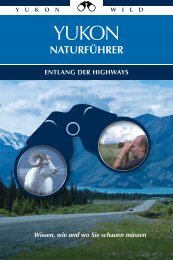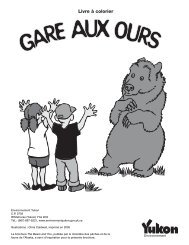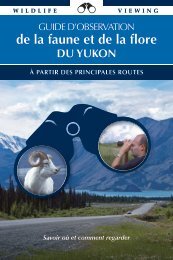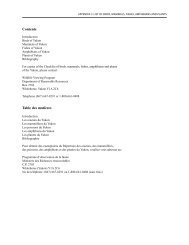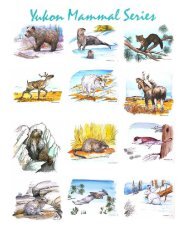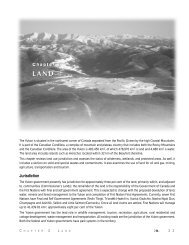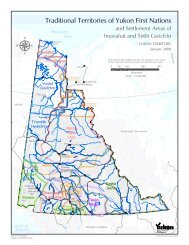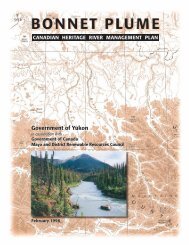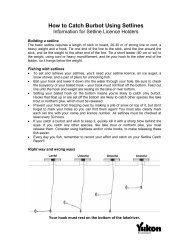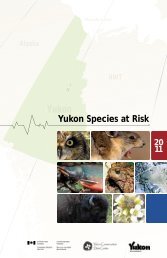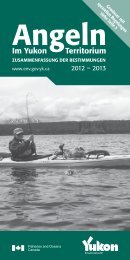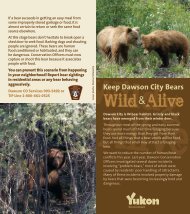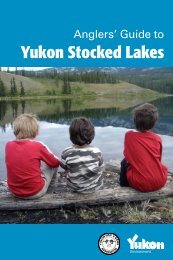Yukon Hunting - Department of Environment - Government of Yukon
Yukon Hunting - Department of Environment - Government of Yukon
Yukon Hunting - Department of Environment - Government of Yukon
Create successful ePaper yourself
Turn your PDF publications into a flip-book with our unique Google optimized e-Paper software.
6<br />
u kidney (whole)<br />
u liver (about 0.5 kg)<br />
u muscle tissue (about 0.5 kg)<br />
u incisor bar (front teeth)<br />
Each sample should be put in a clean plastic bag and frozen as soon as possible. This is<br />
a request for assistance only, not a legal requirement. The results <strong>of</strong> this study will be<br />
summarized in future <strong>Hunting</strong> Regulations Summaries.<br />
Contribute to contaminant knowledge<br />
Although we will no longer be <strong>of</strong>fering a draw for a free flight, your sample donations<br />
will be gratefully received and will be valuable additions to the contaminants program,<br />
allowing us to track contaminant trends in this important northern resource.<br />
Monitoring Wildlife Health<br />
<strong>Environment</strong> <strong>Yukon</strong> needs your help! Samples from hunted animals help us monitor<br />
the health <strong>of</strong> moose, caribou, bison, sheep, mountain goat, deer and elk. Sample<br />
collection kits are available from any <strong>Environment</strong> <strong>Yukon</strong> <strong>of</strong>fice before hunting season<br />
opens and should be returned as soon as possible after the hunt. Hunters are asked to<br />
submit samples <strong>of</strong> fecal matter from their kills, and are welcome to submit any tissues<br />
that appear abnormal for an assessment. Parasites found on a carcass should also be<br />
submitted for identification.<br />
If you’re interested in participating, please contact the Laboratory Coordinator at<br />
(867) 667-5285.<br />
Wanted: Kill locations and hide samples from <strong>Yukon</strong> bears<br />
Because bear research is extremely expensive, information on bear populations<br />
throughout <strong>Yukon</strong> is sparse. <strong>Environment</strong> <strong>Yukon</strong> is trying to obtain information<br />
on grizzly bears and black bears in a cost-effective manner, and hunters can help<br />
tremendously.<br />
If you hunt with a GPS unit, please record the location <strong>of</strong> your kill site and bring that<br />
location in to an <strong>Environment</strong> <strong>Yukon</strong> <strong>of</strong>fice. A wildlife technician will map the location<br />
on a database and ask to take a small sample <strong>of</strong> hide.<br />
Having a very precise location <strong>of</strong> where a bear was killed (within a hundred meters<br />
<strong>of</strong> the kill location) and a small piece <strong>of</strong> hide with the hair (1 square inch) can go a<br />
long way to telling us how healthy a population is. The location ties the biological<br />
information <strong>of</strong> the bear to a precise place and habitat. The hide and hair sample can be<br />
used for DNA, to get information about diet (isotopes), and to tell the stress levels <strong>of</strong><br />
the bear.<br />
Information collected through this process will help direct harvest away from areas with<br />
declining populations and toward areas with healthy populations.





